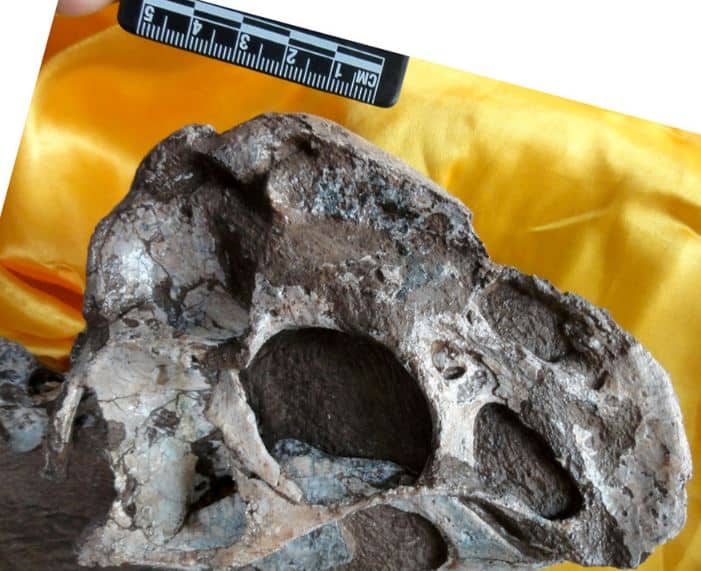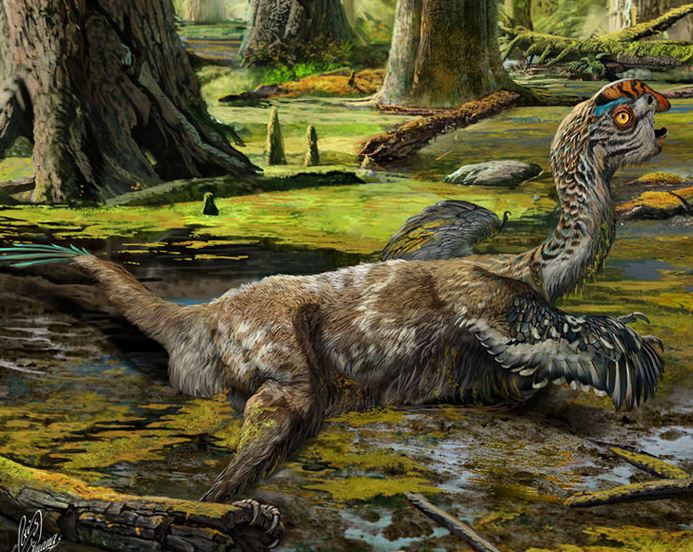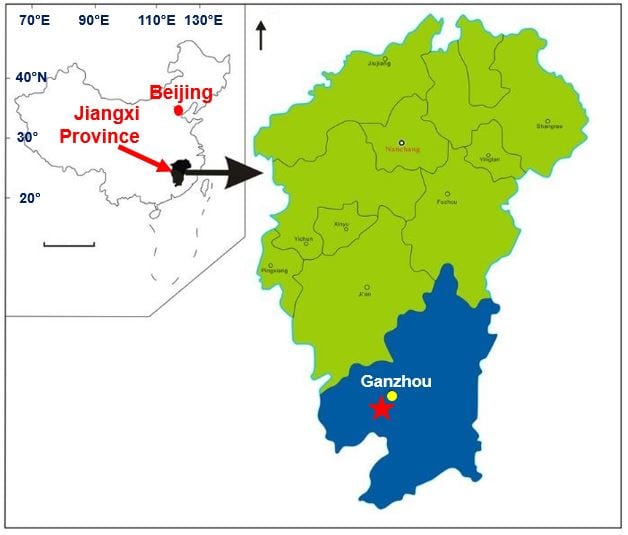A bizarre bird-like dinosaur flourished just before they were all wiped out during the mass extinction, according to a fossil study carried out by Chinese and Scottish researchers. Scientists say that the amazingly complete fossil, which nearly went undiscovered, is providing fascinating data on a family of dinosaurs.
The bird-like dinosaur was found in southern China at a building site. Scientists were amazed and delighted at how well preserved it was. They have nicknamed it Mud Dragon.
The creature was discovered lying down, with its wings and neck outstretched.
 The ‘Mud Dragon’s’ skull. It had a sharp beak and no teeth. (Image: nature.com)
The ‘Mud Dragon’s’ skull. It had a sharp beak and no teeth. (Image: nature.com)
A research team – from the Chinese Academy of Geological Sciences, the Dongyang Museum, and the Grant Institute at the University of Edinburgh – explained in the journal Nature Scientific Reports (citation below) that the bird-like dinosaur may have died in that position after getting stuck in mud between approximately sixty-six and seventy-two million years ago.
Researchers have named this new species Tongtianlong limosus, which in English means ‘muddy dragon on the road to heaven’.
A bird-like dinosaur
The bipedal (two-legged) specimen is an oviraptorosaur, a family of feathered dinosaurs, characterized by having sharp beaks and short, toothless heads.
Some oviraptorosaurs had crests of bone on their heads that scientists believe were likely used as display structures to scare off rivals and attract mates, like modern-day cassowaries.
 An artist’s reconstruction showing Tongtianlong limosus struggling in mud before it died. Scientists suggested that where they found the specimen had been muddy all those millions of years ago. (Image: nature.com. Artist: Zhao Chuang)
An artist’s reconstruction showing Tongtianlong limosus struggling in mud before it died. Scientists suggested that where they found the specimen had been muddy all those millions of years ago. (Image: nature.com. Artist: Zhao Chuang)
According to fossil discoveries over the past couple of decades, this group of flightless creatures was experiencing a significant population boost, splitting off into new species during the 15-million-year period before the dinosaurs were wiped out.
This bird-like dinosaur and other oviraptorosaurs were probably one of the last groups of dinosaurs to diversify before the devastating asteroid collision 66 million years ago which was responsible for the extinction of all non-bird dinosaurs.
Fossil in excellent condition
The fossil was found while workers were excavating using explosives at a school construction site close to Ganzhou.
Scientists said the fossil remains extraordinarily well preserved and nearly complete, despite minor damage caused by a dynamite explosion at the building site.
Dr. Stephen Brusatte, Chancellor’s Fellow in Vertebrate Palaentology at the University of Edinburgh, and colleagues say the finding helps better understand how these last-surviving dinosaurs were thriving before the killer asteroid struck.
 Map of where the bird-like dinosaur fossil was found – near Ganzhou, Jiangxi Province, southern China. (Image: nature.com)
Map of where the bird-like dinosaur fossil was found – near Ganzhou, Jiangxi Province, southern China. (Image: nature.com)
Dr. Brusatte said:
“This new dinosaur is one of the most beautiful, but saddest, fossils I’ve ever seen. But we’re lucky that the ‘Mud Dragon’ got stuck in the muck, because its skeleton is one of the best examples of a dinosaur that was flourishing during those final few million years before the asteroid came down and changed the world in an instant.”
Dr Junchang Lü, from the Institute of Geology, at the Chinese Academy of Geological Sciences, said:
“The discovery of the new oviraptorid dinosaur further indicates that the Ganzhou area of Southern China is a most productive locality of oviraptorid dinosaurs and has a huge diversity of oviraptorosaurs from the late Cretaceous. It will provide important information on the study of evolution, distribution and behaviour of oviraptorid dinosaurs.”
中国江西省赣(カン)州市、白亜紀末の地層からオヴィラプトル科新種記載。泥にはまってありえない姿勢で保存。Tongtianlong limosus 泥通天竜 https://t.co/hf80AQxOBb
論文 https://t.co/HSlBTNadKk pic.twitter.com/1nakwhezEa— パンテオン (@pantheo27705718) November 10, 2016
In an Abstract preceding the main article in the journal, the authors wrote:
“The large number of oviraptorosaurs from Ganzhou, which often differ in cranial morphologies related to feeding, document an evolutionary radiation of these dinosaurs during the very latest Cretaceous of Asia, which helped establish one of the last diverse dinosaur faunas before the end-Cretaceous extinction.”
According to Edinburgh University, this is the latest in a fruitful collaboration with the Chinese Academy of Geological Sciences.
The study was supported by a Marie Curie Career Integration Grant, the the EU Erasmus Mundus Experts Sustain Program, the Fundamental Research Funds for the Chinese Academy of Geological Sciences, and the National Natural Science Foundation of China.
Citation: “A Late Cretaceous diversification of Asian oviraptorid dinosaurs: evidence from a new species preserved in an unusual posture,” Junchang Lü, Rongjun Chen, Stephen L. Brusatte, Yangxiao Zhu & Caizhi Shen. Nature Scientific Reports 6, Article number: 35780 (2016). DOI: 10.1038/srep35780. Published online: 10th November, 2016.
Video – Amazing bird-like dinosaur fossil
The bird-like dinosaur – Tongtianlong limosus – was nearly blown up with dynamite.
